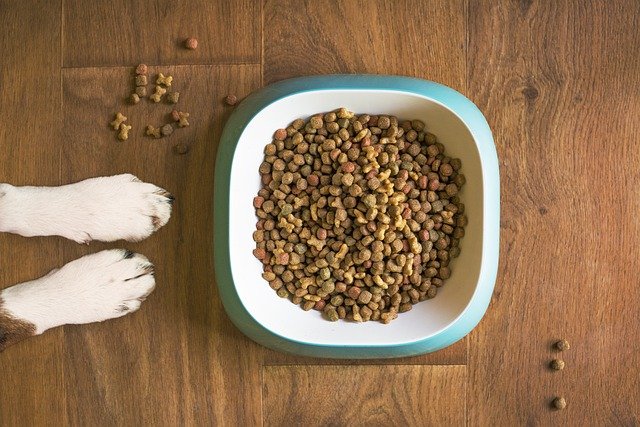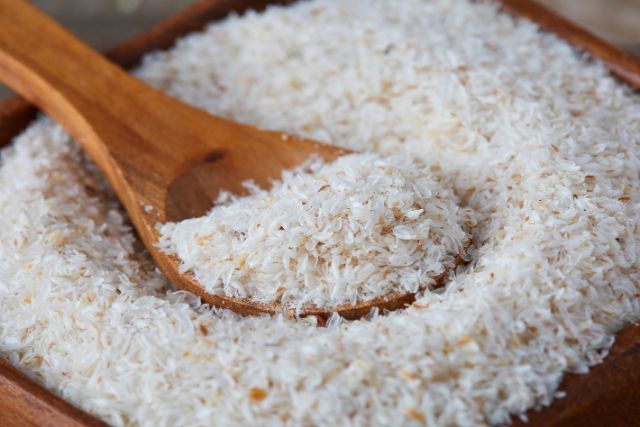Are you looking for ways to add more fiber to your dog’s diet? While fiber is not considered to be an essential ingredient in a dog’s diet, there are a handful of reasons why it may be beneficial to add fiber to a dog’s diet.
Fiber not only helps dogs form normal stools, but some types also promote the growth of healthy gut bacteria.1 If your dog is diabetic, increased quantities of insoluble fiber can improve glycemic control.2
Soluble and insoluble fiber can help dogs with colitis by normalizing the time it takes everything to move through the colon, protecting the gut against toxins, and feeding good gut bacteria and the cells that line the large intestine.3
Fiber can also help to restrict caloric intake in obese dogs undergoing weight reduction by adding bulk to their food,4 helping them feel fuller for longer.5 The passage of bulky stools also promotes the emptying of anal glands.
If you believe that your dog could benefit from consuming more fiber, be sure to check with your vet first. Once you have the green light, you can try one or more of the following 4 ways to add more fiber to your dog’s diet.
1. Feed Your Dog a High Fiber Dog Food
Photo courtesy: Pixabay Public Domain
The easiest way to increase your dog’s fiber intake is to switch to high fiber dog food. While regular dog food should have some fiber in it, high fiber dog foods can contain significantly more.
But when selecting a high fiber dog food, keep in mind that not all options are created equal. It’s important to do your research. At the very least, always read the nutrition label to check if the formula is, in fact, high in fiber. High fiber dog foods tend to range from around 5% to 16% crude fiber (“crude” simply refers to the way in which fiber levels are measured). Over the counter foods are usually on the lower end of this range, with prescription dog foods at the higher end.
Unfortunately, dog food labels are notoriously difficult to decipher. While the crude fiber content is listed in a table called the “Guaranteed Analysis,” the percentage listed is the maximum percentage, rather than an absolute amount.6 To make matters more confusing, this amount includes most, but not all, insoluble fiber, and doesn’t factor in any soluble fiber.
This brings us to the next problem with trying to decipher dog food labels for fiber content: they don’t provide much information regarding the types of fiber that are included. It’s hard to pick the right high fiber food for your dog when you don’t know how much of what type of fiber is included.
So how can you work out which high fiber food is best for your dog (or if you should even make the switch)? The simplest answer is to consult your vet.
2. Integrate Fiber-Rich Foods Into Their Diet
Another way to increase your dog’s fiber intake is to add fiber-rich foods to their diet. Of course, in order to do this, you’ll need to know which foods are high in fiber, and you shouldn’t add additional foods to your pet’s diet without first consulting with your veterinarian. Add too much and you can end up with nutritional imbalances. Too little, and you’re unlikely to see much of an effect.
High fiber fruits and vegetables, including apples, blueberries, and carrots, are good treats for dogs or can be ingredients in a nutritionally complete and balanced dog food.7
Pumpkin is often recommended as a source of fiber for dogs. While pumpkin does contain more fiber than most fruits and vegetables, it isn’t as fiber-rich as you might think.8 You would need to give your dog a sizable amount of it to equal the fiber percentages found in prescription formula high fiber dog foods.
To ensure you give your dog fiber-rich foods that are suitable for their particular health needs, ask your vet for advice.
3. Add Fiber Supplements to Their Diet
Another way to give your dog a fiber boost is to add a fiber supplement to their diet. Fiber supplements, such as psyllium husk, have been shown to offer a number of positive benefits including improved intestinal health, reduced constipation, improved quality of fecal matter, and easier defecation.9
While fiber supplements may seem like a quick and easy way to give your dog an extra dose of fiber, it is important to seek your vet’s advice prior to adding them to your dog’s diet. Adding more fiber (of any kind) can impact the absorption of nutrients, so it’s best to check with your vet who can determine if your dog needs a fiber supplement at all, and if so can recommend the right kind and the right dose.
If you get the green light, be sure to take things slowly. Your vet will likely recommend that you gradually add the fiber supplement to their meals. If your dog doesn’t react well to the fiber supplements, immediately stop giving them and contact your veterinarian.
4. Consult Your Vet
Adding more fiber to your dog’s diet may not seem like a decision that warrants a trip to the vet. However, altering your dog’s diet in any significant way can impact their health. Adding fiber could indeed be beneficial… but it could also lead to undesirable side effects. Too much fiber can decrease the absorption of important nutrients and result in loose stools, frequent defecation, and reduced palatability of the dog food.10
Your vet will be able to give you the expert guidance you need to address any health problems your dog is experiencing. If they determine that your dog could indeed benefit from more fiber, they can tell you which of the strategies mentioned above would be most appropriate based on your dog’s particular needs.
Beyond that, if you’re looking for additional resources to help keep your puppy healthy and looking good we also have a series of buying guides to help you select the best dog ear cleaner solution, the best dog clipper, the best dog clippers for poodle hair, and our guide to finding the best brush for Aussies.
If you have additional questions about the right dog food for your new pup, we’ve created a series of resources to help you get the information you need:
- A large list of the human foods that dogs can and cannot eat
- A list (and ranking) of the best automatic dog feeders
- A guide to adding fiber to a dog’s diet
- An article on how long it takes for a dog to digest food
Also, check out some of our other dog food and nutrition based resources for your pup:
- How to Add More Fiber to Your Dog’s Diet
- How Long Does it Take for a Dog To Digest Food?
- The Farmer’s Dog vs. Nom Nom Now vs. Ollie’s Dog Food Reviews
- The Best High Fiber Dog Food
- Best Foods for Dogs with Allergies
- The Best Small Breed Puppy Foods
- The Best Dog Food for Dobermans
- The Best Automatic Dog Feeders
- The Farmer’s Dog Food Review
Article Sources
Pet News Daily uses only high-quality sources, including peer-reviewed studies, to support the facts within our articles. Read our editorial process to learn more about how we fact-check and keep our content accurate, reliable, and trustworthy.
- Heinze C. Fiber frustrations. Vetnutrition.tufts.edu. Published November, 2019. Accessed March 5, 2021.
- Linder D. What’s the best diet for my dog with diabetes? Vetnutrition.tufts.edu. Published January, 2020. Accessed March 5, 2021.
- Llera R, Downing R. Nutrition for dogs with colitis. Vcahospitals.com. Accessed March 5, 2021.
- AAHA. Dietary therapy goals and management. Aaha.org. Accessed March 5, 2021.
- Flickinger B. The role of fiber in weight loss diets. Aaha.org. Published. August 31, 2011. Accessed March 5, 2021.
- Heinze C. Fiber frustrations. Vetnutrition.tufts.edu. Published November, 2019. Accessed March 5, 2021.
- Avondale Animal Hospital. Fruits and vegetables your pet can safely eat. Avondaleanimal.com. Accessed March 5, 2021.
- Freeman L. The problem with pumpkin. Vetnutrition.tufts.edu. Accessed March 5, 2021.
- Tortola L, Zaine L, Vasconcellos R, et al. Psyllium (plantago psyllium) uses in the management of constipation in dogs. Vin.com. Accessed March 5, 2021.
- National Academy of Sciences. Your dog’s nutritional needs: A science-based guide for pet owners. Nap.edu. Published 2006. Accessed March 5, 2021.



